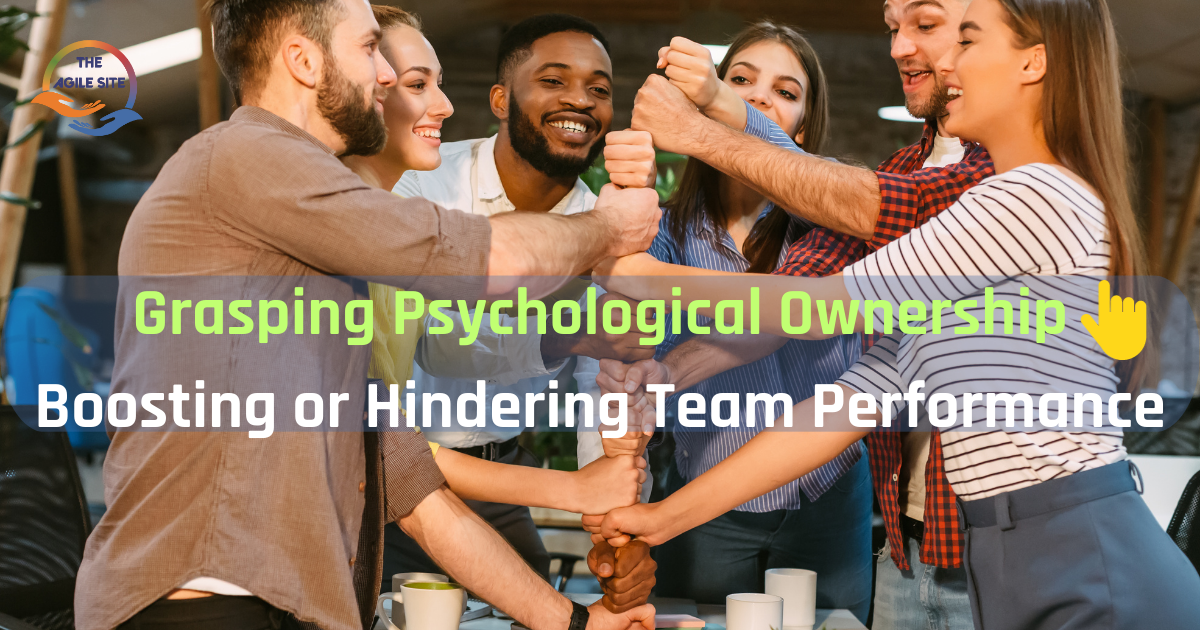11205, Knolls End Spotsylvania, VA 22551, United States
Building Positive Psychological Team Ownership: 10 Actionable Steps
In this blog, we explore how to build positive psychological team ownership by focusing on the four enablers: The team mission, Celebrating achievements, Working in small steps, Seeing failure as learning, Giving the team autonomy and Ownership, Celebrating outward, A written team agreement, Developing a positive self-image, Promoting ongoing learning, and Developing a psychologically safe team environment. By implementing these ten actionable steps, team members can develop collective psychological ownership, which can significantly increase their Motivation, Creativity, Compliance, and Loyalty to the team and its work.
Understanding Psychological Ownership: How It Can Enhance or Hinder Team Effectiveness
Psychological ownership is a feeling that one has ownership responsibility for something. Individuals that develop psychological ownership may or may not feel an actual product or tangible ownership – it does not matter. It is all about ownership responsibility. Now the problem is not psychological ownership. It is with how the individual who possesses a sense of ownership responsibility reacts and whether they feel they share that sense of ownership responsibility with the team. Psychological ownership within the team can be manifested as the ownership of a product or solution—the ownership of a plan, a mission, and an idea or option, to name a few.
Hamburger Method: A Simple Way for Teams to Vertically Split User Stories
Understanding the Negative Impacts of Psychological Ownership in the Workplace
The negative side of psychological ownership in the workplace can lead to emotionally driven behaviors, reluctance to share ideas, resistance to change, and other negative effects that impact team dynamics and productivity. This blog provides an overview of the common causes of negative psychological ownership and outlines actionable steps that team leaders can take to manage and lessen its impact, including addressing the underlying causes, building psychological safety, and lessening the impact of avoidance orientation and overvaluing ownership.
Top Strategies for a Scrum Master to Facilitate Meetings Effectively
In this blog, Scrum Masters will learn strategies to facilitate meetings, such as Daily Scrum, Sprint Planning, Review, and Retrospective. It includes tips for effective meeting management, like preparing in advance, active listening, and using the parking lot technique to keep the meeting on track. The blog also covers managing participants who dominate or do not participate in the discussion, as well as assigning roles in team meetings.
A Comprehensive Guide to Guild Facilitation
In the early days of the guild, the key to success is the preparation and involvement of the guild members. As the guild gets going, the guild members often become more involved, and the guild may shift focus as priorities change. Guilds are a great way to build the skills of the members and find better ways of doing things through continuous improvement activities.
10 Ways to Build Positive Psychological Team Ownership: A Guide
Meet as a team often to discuss building positive psychological team ownership, a goal-oriented team mindset, and creating a psychologically safe environment. Ensure that the team members understand psychological team ownership and psychologically safe team environment and why they matter. Get the team to take ownership to build positive psychological team ownership and create a psychologically safe team environment. Make it clear that you expect results.
Agile Values: Individuals, Interactions, and Customer Collaboration
The objective here is not to eliminate documentation but to ensure that the customer’s needs are met. Meeting customers’ needs are best achieved through regular ongoing discussions and short-feedback-loops sessions. Written documentation is great to support a discussion but should not replace regular ongoing discussions and short feedback loops. The team members will want to ensure they meet the customers’ needs.
How to Use the A:B Solutioning Technique for Alternative Problem-Solving
A:B Solutioning" aims to build psychological safety within the team. By building confidence to take risks in sharing unique ideas and alternative approaches.
Agile and Kanban in Software Development Projects: Understanding their Relationship
Agile and Kanban share many similarities, but they have distinct differences. Agile is a philosophy, while Kanban is a method. Agile principles and values are intended to create a flexible and adaptive environment for development teams, while Kanban is a tool to help teams manage their workflow. Agile is more focused on the team’s interactions and communication, while Kanban is more concerned with the management of work items and their flow through the system.
Agile Business Analysis for Agile Coaches: An Overview
Agile methodologies have transformed the way software development is done, and business analysis is no exception. Business analysts play a critical role in defining and refining the requirements of a project. To ensure the project is successful, business analysts must collaborate closely with the development team and other stakeholders. Agile coaches can play an important role in helping business analysts to manage Agile business analysis effectively. In this blog, we will explore the role of Agile coaches in supporting business analysts and how to manage Agile business analysis effectively.
Effective Management of Cross-Functional Teams in Agile Business Analysis
If you're managing cross-functional teams in Agile business analysis, consider adopting a cross-functional approach to improve collaboration and reduce the risk of delays and defects. Clear communication, collaboration, prioritization, the use of visual tools, and continuous improvement are key to effective cross-functional team management. To learn more about Agile business analysis and how to manage cross-functional teams, visit TheAgileSite.com for additional information and resources. Start using a cross-functional approach to Agile business analysis today to take your project to the next level!
Agile Business Analysis: A Guide for Executives to Stay Competitive
Agile business analysis involves working closely with the development team and other stakeholders to define and refine the requirements of a project. This approach enables companies to quickly respond to changing customer needs and deliver high-quality products and services. Agile business analysis is typically used in software development but can also be used in other areas of the business.
Agile Business Analysis for Remote Teams: An Overview
Remote work has become increasingly popular in recent years, and with it comes the need for effective management of Agile business analysis in remote teams. Agile business analysis involves working closely with the development team and other stakeholders to define and refine the requirements of a product. In this blog, we will explore how to effectively manage Agile business analysis in remote teams.
Agile Business Analysis for Stakeholders: An Overview
Stakeholders play a critical role in Agile business analysis. By providing input, prioritizing user value, participating in Sprint Reviews, collaborating with the development team, providing regular feedback, and being available for communication, stakeholders can effectively support and participate in Agile business analysis.
Agile Business Analysis for Startups: An Overview
In startups, the role of Agile business analysis is even more crucial, as the product development process needs to be efficient and quick. Agile business analysis provides startups with a flexible and adaptable framework that can help them achieve their business objectives in a timely manner.
Agile Coaching Best Practices: An Overview
Agile coaching is a critical component of successful Agile implementation. By building trust, coaching teams effectively, and driving change, Agile coaches can help teams and organizations adopt and embrace the Agile mindset, values, and practices. These best practices can help Agile coaches be effective in their roles and promote a culture of continuous improvement.
A Beginner's Guide to Agile Coaching: Tips and Strategies to Get Started
Agile coaching is a critical component of Agile implementation. As a beginner, it's essential to understand the basics of Agile methodologies and how to get started as an Agile coach. In this blog, we will provide a beginner's guide to Agile coaching, including the basics of Agile methodologies and how to get started as an Agile coach.
Agile Coaching for Business: Driving Growth and Innovation
Agile coaching can be a powerful tool for businesses looking to drive growth and innovation. By helping businesses to adopt and implement Agile methodologies effectively, Agile coaches can help businesses to stay ahead of their competition, increase customer satisfaction, and drive innovation.
Agile Coaching for Designers: How to Effectively Participate in Agile Software Development
Designers are an essential part of Agile software development teams. They create user-centered design solutions that cater to the needs of the customers and contribute to the project's success. However, designers can face unique challenges when working in an Agile environment. Agile coaches can help designers overcome these challenges and effectively participate in Agile software development. In this blog, we will provide an overview of how Agile coaches can support designers in Agile software development.





















